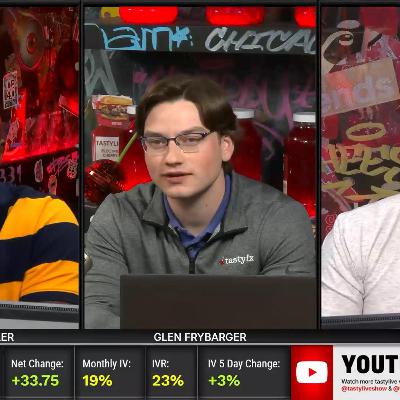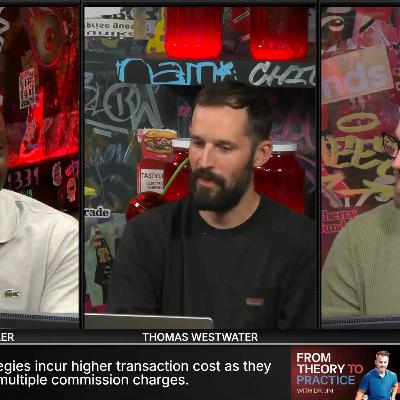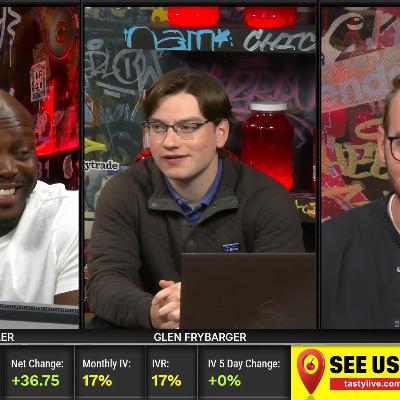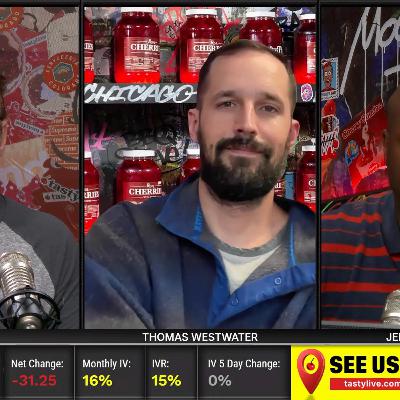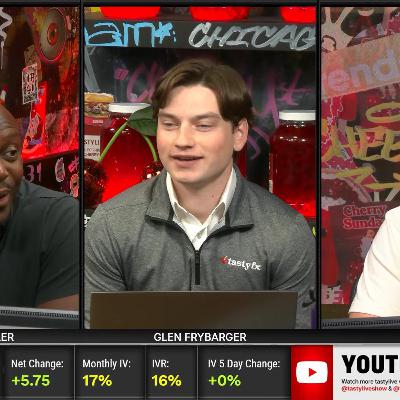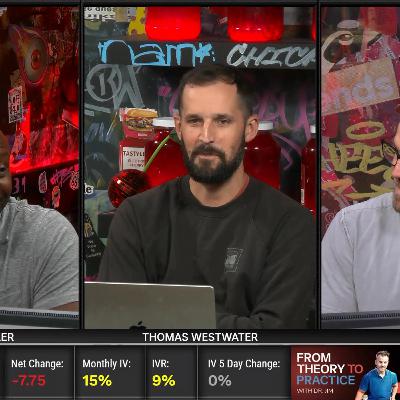Discover tastylive: Options Trading Concepts Live
tastylive: Options Trading Concepts Live

tastylive: Options Trading Concepts Live
Author: tastylive
Subscribed: 1Played: 13Subscribe
Share
© ℗ & © copyright 2013 - 2025 tastylive. All Rights Reserved.
Description
Mike, Jermal, Katie, Ryan, Glen, and Thomas take trading questions live on YouTube chat and explain the answers in depth using the tastytrade platform and graphics.
2504 Episodes
Reverse
In Wednesday's Options Trading Concepts Live, Glen provided a comprehensive U.S. dollar correlation analysis across multiple asset classes, revealing an undefined market regime with some surprising relationships. The analysis showed extreme correlations among dollar pairs, indicating U.S.-specific factors are driving price action despite the government shutdown. Euro-dollar and dollar-Swiss franc correlation reached 0.91, while dollar-CAD showed less correlation to other pairs at 0.6-0.7. Cross-asset correlations revealed classic relationships, with 10-year treasuries moving with dollar-yen, and Australian dollar showing exposure to gold, copper and S&P 500. Interestingly, crude oil and U.S. dollar currently show a positive correlation, though the hosts agreed this is likely coincidental rather than a tradable trend. The U.S. dollar/equities relationship remains unstable, flipping between positive and negative correlation throughout 2023, creating what Glen called "no-man's land" for traders seeking clear directional signals.
Thomas Tuesday's analysis suggests crude oil is establishing a new trading range after breaking below the $60 support level, with forecasters projecting sub-60 prices through Q2 2025. Calendar spreads have shifted from backwardation into contango, indicating weakening physical demand. Market positioning shows longs have capitulated while shorts have built significant positions. With breakeven prices for new wells ranging from $61-$70, production growth may stall at current price levels. Mike constructed a "chicken iron condor" trade with 55-54 put spread and 63-64 call spread, collecting $400 premium with $600 risk. The trade positions around key support at $55 and resistance at $63, anticipating choppy price action in the newly forming range. The broader market showed significant volatility, with SPX experiencing a 125-point intraday range as traders navigate headline-driven swings across markets.
In today's session, traders analyzed market movements as equities faced selling pressure with the S&P 500 down 20 points and NASDAQ down 65. Despite the red day, volatility remained relatively contained with VIX only up 40 cents, still under 17. Mike presented a Google diagonal spread, betting on a pre-earnings rally with a December call and October 31st short option for a $760 debit. Jermal highlighted Ethereum's underperformance versus Bitcoin with a bullish ZEBRA trade costing $576, while another trader demonstrated a similar diagonal spread approach for $441. Katie discussed natural gas seasonality with a synthetic jade lizard/dynamic width iron condor collecting $510, eliminating upside risk while maintaining downside protection ahead of winter months. The team noted gold's significant selloff, creating potential trading opportunities, while discussing correlation risks if multiple asset classes continue declining simultaneously. They emphasized monitoring VIX and volatility futures curves as key indicators for determining market direction rather than reacting to minor pullbacks.
US equities, US dollar and gold all rally midweek - a rare combination confusing traders. Japanese yen weakens dramatically after elections with USD/JPY near 153. Watch for FOMC minutes today and Powell's speech tomorrow as markets show surprising calm ahead of potential volatility.
Bitcoin futures reached new all-time highs at $127,240 during Monday's trading session, marking the sixth consecutive green day. The leading cryptocurrency has surged from $110,000 to $127,240 over the past six trading sessions, with Ethereum showing even stronger performance, up 3.5% on the day. Ryan Grace highlighted that October historically delivers the strongest monthly returns for Bitcoin, averaging 20% gains over the past decade. The fourth quarter generally provides the best performance period for crypto markets. Market participants discussed potential catalysts, including the possibility of new ETF approvals for Solana and XRP by month-end. Notably, Grayscale announced plans to stake Ethereum in their ETF, which could attract dividend-focused investors. Analysts noted Bitcoin market cap dominance has increased to nearly 60%, though some altcoins are showing signs of outperforming Bitcoin. When assessing pullback potential, historical data suggests 10-15% corrections are common, even during bullish phases.
XLV, the healthcare ETF, surged from $134 to $144 in just two days, exceeding its implied volatility projections. This movement reflects significant gains across several healthcare stocks, creating potential opportunity in the sector. With implied volatility under 20%, traders are eyeing directional trades with defined risk parameters. Meanwhile, Lululemon (LULU) appears to be finding support around $170 after significant losses, prompting interest in bullish strategies like put spreads. Costco (COST) and UnitedHealth (UNH) continue to attract attention, with traders implementing diagonal spreads to capitalize on potential recoveries with defined risk. Oil futures also present opportunity at multi-month lows, with traders entering long positions around $60 using micro contracts (MCL).
In today's Options Trading Concepts Live, Mike, Jermal, and Glen Freibarger from tastyFX discussed market implications of the U.S. government shutdown. Glen presented historical data showing the U.S. dollar typically weakens during shutdowns, with gold often outperforming. While stocks remain relatively unaffected, the dollar has consistently declined about 1% during past shutdowns. The 2018-2019 shutdown (35 days under Trump) saw significant dollar weakness around the two-week mark. With prediction markets suggesting this shutdown could last until mid-October or longer, traders should watch British pound and Japanese yen pairs for potential moves. The shutdown also means no economic reports from agencies like BLS, canceling Friday's nonfarm payroll report and potentially the October 15 CPI release. In FX markets, Glen highlighted the Australian dollar/New Zealand dollar pair showing signs of reversal after New Zealand's recent weakness. Traders discussed the benefits of positive carry positions in FX trading, where overnight financing adjustments can enhance profits. Bitcoin and Ethereum showed strength, both up over 3% for the session.
The S&P 500 remained relatively flat, with analysts noting historically positive market performance during government shutdowns. According to data presented, during the 35-day shutdown in 2018-2019, the S&P actually gained about 9%. Silver historically outperforms during government shutdowns, prompting several traders to enter short put spreads at the $45-45.25 level on the day's 1% dip. Gold also tends to perform well during shutdowns, though typically not as strongly as silver. Without economic data releases during a shutdown, markets may experience sideways trading, potentially benefiting iron condor strategies. Rate cut probabilities increased despite the looming shutdown, with markets now pricing a 96.7% chance of an October cut and 76% for December. Agricultural commodities continue facing pressure from record yields and limited Chinese purchasing, with corn, soybeans and wheat all down over 1%.
Bitcoin surged 5% today as cryptocurrencies showed strength alongside precious metals, with IBIT trading volume exceeding most major stocks. Ryan Grace highlighted Bitcoin's recent stability despite pullbacks, noting its resilience at $114,000 after briefly dipping to $108,000. The analysts discussed how Bitcoin's market cap dominance has decreased from 64% to 58% over recent months, allowing Ethereum to gain ground. Grace emphasized that despite current low volatility (Bitcoin's 30-day realized vol at just 24%), history suggests volatility could double quickly. Gold's remarkable 46% year-to-date performance compared to Bitcoin's 21% prompted discussion about fiat currency concerns. The panel noted that Bitcoin's Google Trends data shows interest at a five-year low despite favorable macroeconomic conditions with rate cuts and inflation—suggesting potential for significant upside as retail interest returns.
In this episode of Options Trading Concepts Live, hosts Nick Battista, Mike Butler and Katie McGarrigle discuss recent market movements, including a weak performance from the E-minis (ES) and tech stocks like Netflix (NFLX) and Palantir (PLTR). They share trade ideas, including a defined-risk upside trade on Costco (COST) ahead of its earnings and a put diagonal spread in Palantir. The hosts also introduce Tasty Live's new Money Match promotion, offering a 1% cash match for new accounts.
In this episode of Options Trading Concepts Live, Nick Battista, Mikey Butler, and Glen Frybarger discuss market conditions, focusing on the performance of major indices and various trading strategies. The hosts analyze recent Federal Reserve comments and their impact on currency pairs, particularly the U.S. dollar, euro, and yen. They also explore trading costs associated with currency futures versus spot FX, emphasizing the importance of understanding interest rate differentials. Several trade ideas, including trades on Tesla (TSLA) and Applied Digital (APLD), are presented, alongside insights on straddles and strangles.
In this episode of Options Trading Concepts Live, hosts Nick Battista, Mikey Butler, and Thomas Westwater discuss current market trends, including a slight sell-off in E-mini futures (ES) and changes in the commodities market. They highlight a bearish outlook on lean hogs (HE), noting seasonal weaknesses and positioning in the market. Westwater also mentions a new diagonal spread in gold (GLD) and reflections on the gold rally as a potential indicator of underlying economic conditions. They encourage viewers to engage and ask questions during the show.
In today's episode of Options Trading Concepts Live, hosts Nick Battista and Mikey Butler discuss the current market trends, highlighting a strong rally driven by major stocks like Apple (AAPL) and Tesla (TSLA). They review recent trades, including a successful diagonal spread in AMD (AMD) and a pair trade in QQQ and IWM that netted a profit. They explore trade ideas in gold (GLD), noting its recent surge, and discuss strategies for managing losing positions in diagonals. The episode wraps with insights on upcoming earnings and market expectations.
In today's edition of the Liz and Jenny Show, Dan Cecilia discusses a recent pullback in the cryptocurrency markets, pointing to liquidations in futures and a shift of investor interest towards safer assets like gold. He explains the concept of altcoins, discussing their market cap growth and defining seasons of speculative trading. The hosts also touch on trading strategies such as basic options, including broken wing butterflies and put spreads in natural gas, while emphasizing the importance of understanding market risks and maintaining liquidity.
The stock market pushed up to another record high after the Fed cut rates despite rising inflation. What can possibly go wrong? tastylive's Head of Global Macro Ilya Spivak previews the week ahead, highlighting the latest S&P Global PMI data and the Fed's favored PCE inflation gauge.
A tastylive market analysis reveals that extreme market movements often lead to counter-trend moves the following day, challenging the "trend is your friend" adage. After examining 10 years of data across 40 tickers, researchers found that following a two standard deviation upward move, markets show a 58% probability of reversing downward the next day a significant shift from the normal 45% probability.
The asymmetry is notable: 74% of studied tickers demonstrated mean reversion after substantial rallies, while only 58% bounced after major declines. Apple shows a particularly strong 15% tendency to fade after rallies, prompting Tom Sosnoff to immediately sell Apple stock during the segment based on its recent extreme upward movement.
The findings support a contrarian approach rather than momentum trading, though researchers caution that position sizing should reflect the speculative nature of these probabilities.



